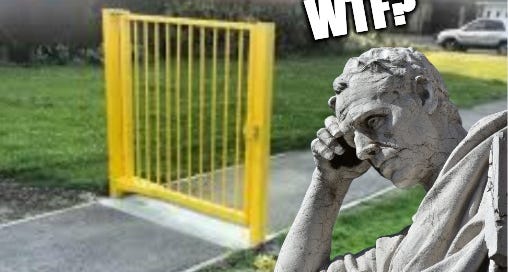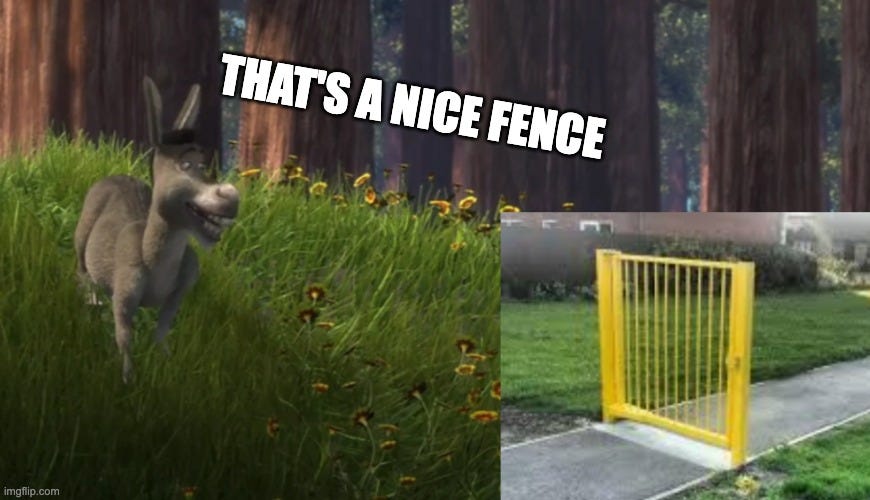Have you ever seen/heard something and immediately decided it was stupid?
So stupid that you felt compelled to do something about it?
Maybe a process at work or how a friend does something…
“Who could’ve thought this was a good idea?!”
I have.
A lot.
I may’ve even over-zealously expressed my strong, newly-formed opinion on the matter. Going from having little knowledge/interest to knowing how to improve things in seconds - sound familiar?
We see this happening all over social media when keyboard warriors jump straight from being pathology experts, to geopolitical strategists, then economists and, most recently, to wildfire experts - all from the safety of their sofas, working on limited information and - more often than not - only a thimble’s depth of knowledge.
Don’t ever take down a fence until you know the reason it was put up.
-G.K. Chesterton
First-Order Thinking
Partaking in this behaviour is committing the cardinal sin of ‘first order thinking’, which is when you make a quick decision based upon little thought and only considering the immediately available information and immediate consequences.
It’s easy to do and feels good.
Have you ever found yourself cutting someone off, before they’ve even finished explaining, to impart your wisdom? If so, you’ve fallen into the same trap!
What first order thinking fails to acknowledge is the reason for the status-quo.
Why something is the way it is in the first place.
If you don’t understand why something exists, then you’re not qualified to change it.
Apparently, J.F.K often referred to a heuristic called Chesterton’s Fence when it came to making decisions: “don’t ever take down a fence until you know the reason it was put up”.
If a fence exists, it’s because somebody thought it was a good idea put one there.
There’s a reason for it.
They don’t miraculously pop out of the ground.
We can only gain an understanding of why something exists by asking questions and observing.
Once we have that understanding, then - and only then - are we in a position to make/suggest changes.
‘The Fence’ in Practice
As a Chartered Financial Planner, my job is to help people gain clarity and improve their circumstances through proper financial planning (investing to support future income needs in retirement, withdrawal strategies, tax-efficiency etc.).
It can be tempting, upon hearing the initial details of someone’s situation, to jump straight to conclusions and provide immediate answers; however, that’s risky business and would likely lead to sub-par outcomes.
Before ripping apart an existing structure and rebuilding it, one must first take a step back and understand why the current structure (the fence) exists in its current form:
Why was it set up the way it is?
What is its purpose?
Is it still fit for purpose?
What are the benefits of it?
What are the limitations?
Where is there room for improvement?
Could the client’s aims be met more efficiently with a different structure?
Just because there are lots of things you could do, that doesn’t mean you should.
The Toolbox
There are many tools at my disposal for helping people with their finances, but I don’t empty out my entire (metaphorical) toolbox at the first opportunity, “here’s everything I can do based on the first few things you told me”.
Whilst it’s tempting to grab the hammer and start swinging at the fence, it’s instead important to discover as much as possible about the needs, wants and circumstances of the people I’m speaking to.
Once I have a deep enough understanding, I can then reach into my toolbox and select the appropriate tools for the job.
Closing Thoughts
Be wary of jumping the gun when making decisions.
Most well-meaning advice from friends/family/that random bloke propping up a bar shilling out stocks tips, does not account for your unique set of life experiences, circumstances and why certain ‘financial fences’ exist.
If and when you engage with someone to provide you advice or a service, don’t expect them to provide the answers straight away.
In fact, immediate solutions could well be a red flag.
Don’t remove a fence without first understanding why it’s there.
Want to discuss your financial future?
Clicking the button will generate a contact form.
We'll then have an initial conversation to better understand your needs/wants/aspirations and to see whether my services would be a good fit.
Thanks for reading,
Tom Redmayne
Chartered Financial Planner/Fence Admirer
Supporting my work
If you enjoy my content, here’re some simple ways to lend support:
Giving the article a like (if you liked it) - this helps the Substack algorithm find me and recommend me to new readers.
Subscribing (if you haven’t already).
Sharing also really helps my work find a wider audience:
Thank you!
The value of investments can go down in value as well as up, so you could get back less than you invest. It is therefore important that you understand the risks and commitments.
This is not personal advice based on your circumstances.
All views are my own.







I'd not heard of The Fence before Tom but it's a great reminder for us all to stop and think particularly when itching to show our knowledge and value as professional advisers, love it.